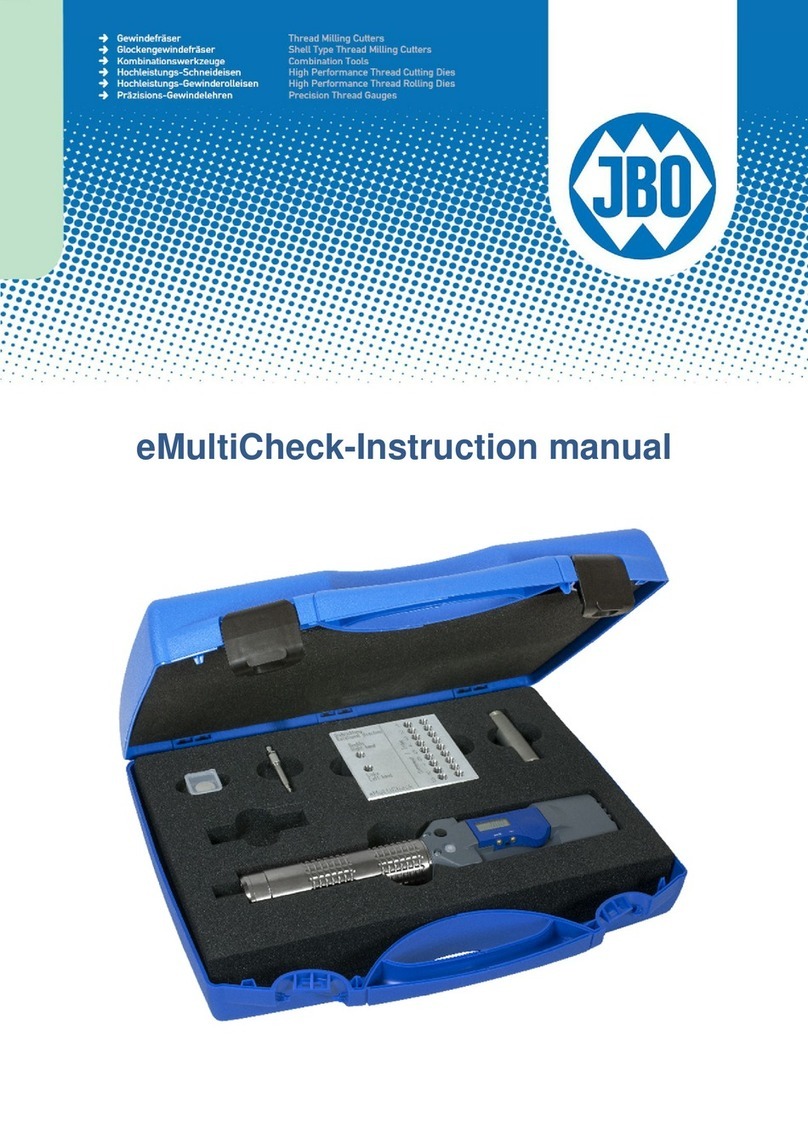
5
JBO·eMultiCheck2.0USB ENG·1906
During this phase of screwing in, if the plug gauge GO eMC is blocked, it is turned back in the opposite
direction by 180° and phase 2 is started again.
After one more revolution the device accelerates again and the torque is adjusted to the set target torque
(phase 3).
When the thread depth is reached (the end) the device is switched off due to the set torque being reached
(phase 4).
In phase 4, the measured thread depth is stored in the memory and used as a reference for the next
measurement. This can be influenced with the settings (please also see the "Setting“ section).
The measured thread length can now be read off the display (the display must first be switched on by
pressing the button. Please note: the display and the motor/controls are independent of one another, i.e.
no data exchange takes place between these units).
2.1.1 Saving thread depths
If the RPM should be reduced during a subsequent measurement ( see 2.2 ) to ensure a smooth run up
on the thread end the thread depth have to be saved during the first measurement. Therefore you have to
press and hold the blue button “C” for 1 second after reaching the thread depth ( the decive vibrates 1x ).
The thread depth is no saved on the device and the speed is reduced with each subsequent measurement
(same thread depth) 1-2 turns before reaching the final depth.
By pressing the blue button "C" for 2 seconds (device vibrates 2x) the saved thread depth is deleted. In
this configuration, the RPMwill be not reduced.
2.1.2 Manual mode
Pressing and holding down the black button (button B) switches the device to manual mode. Here, the
device is switched over immediately to the fast speed and switched off again when the set torque is
reached.
2.1. Through-holes
To check thru holes the eMultiCheck must be configured with our eMutliCheck software.
The pitch and the length of the thru hole must be specified in the software. When check the thread
measurement is stopped after reaching the programmed depth + 2x the pitch (continuity of the thread is
ensured). Then, the thread plug gauge is as usual unscrewed on the white button "A".
2.2 Subsequent measurement:
In a subsequent measurement, the sequence of phases 1-3 is the same as in the first measurement. Before
the last measured thread depth is reached, however, the speed is reduced, in order to prevent contact at
the end and to move carefully (gently) against the thread. This ideally reduces the load on the component
and the thread plug gauge.
If the thread is deeper, the speed is automatically increased again and is the same as in the normal
measuring sequence.
2. Screwing out:
The plug gauge is unscrewed from the component again by pressing the white button (button A) on the
front of the device. This is done by pressing the button briefly and the device stops automatically when
the plug gauge GO eMC has turned back completely again. If the black button is pressed and held down,
the plug gauge turns until the button is released again. In this mode, the torque is not limited.
2. .1 Manual mode
If the white button is pressed and held down, the device switches to manual mode. In this mode, the
device is set to the maximum torque until the button is released again.




























